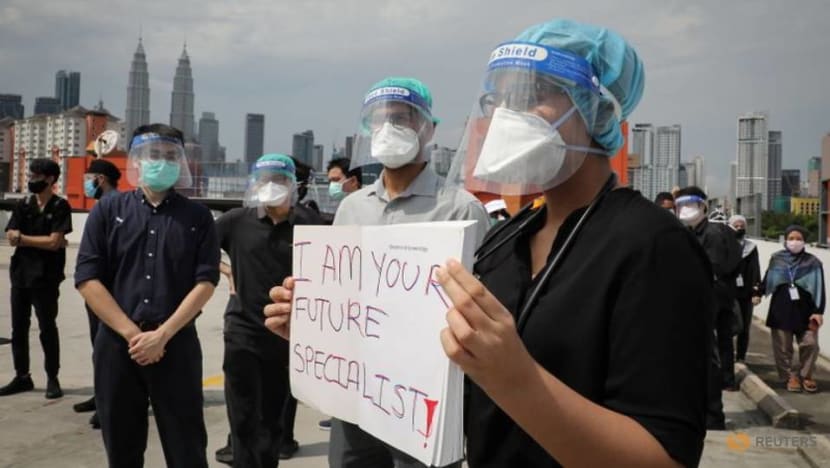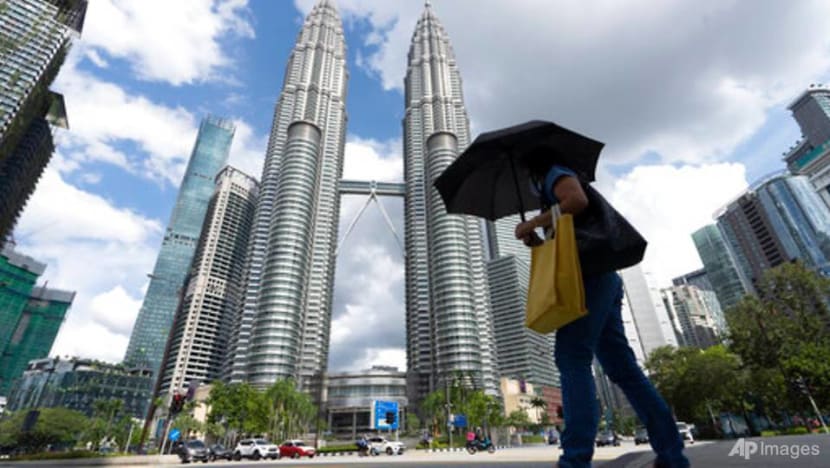Commentary: Malaysia’s coffers run dry as COVID-19 pandemic worsens
The Malaysian government has limited fiscal space for COVID-19 relief, after running budget deficits for over 20 years, says a researcher.

Contract doctors participate in a walkout strike at Kuala Lumpur Hospital in Malaysia on Jul 26, 2021. (Photo: Reuters/Lim Huey Teng)
KUALA LUMPUR: Malaysia continues to grapple with its growing second wave of COVID-19. The country of 32 million people has now exceeded 995,000 infections and 7,900 deaths since the start of the pandemic.
In early June, the number of infections increased by more than 7,000 in a single day, rising to over 10,000 daily cases in July. For a country in political crisis, the poor state of public health has had inevitable economic consequences.
In May 2020, unemployment rose by 5.3 per cent after the first lockdown in March 2020 had a severe impact on Malaysia’s economy.
The economy picked up as the year progressed – by January, the unemployment rate dropped to 4.9 per cent – but those gains were scuppered by elections in East Malaysia.
READ: Commentary: Malaysia king’s role comes into sharper focus as country sails through bleakest COVID-19 days
This was followed by the lax observance of standard operating procedures during the month of Ramadan, requiring a strict Movement Control Order (MCO) to be extended from Jun 1 to 28.
Up to 2 million jobs could be lost in 2021. Although the government has provided wage subsidies, cash handouts for the most disadvantaged and support for small and medium-sized enterprises, these outlays have put further stress on an already weakened fiscal position that has borne the brunt of the 1MDB scandal.
A series of support initiatives – Penjana, Prihatin, Permai, Permerkasa, Permerkasa+ and Pemulih – have been extended by the government, totalling RM380 billion (US$90 billion).
READ: Commentary: Malaysia’s Parliament reopening may not fix country's current woes; much depends on how MPs behave
DEEP DISSATISFACTION REMAINS
There remains a great deal of dissatisfaction with official efforts, despite Kuala Lumpur committing to as much fiscal relief as possible for a country of its level of income and development. The Malaysian government’s relief packages rose to 23 per cent of GDP in December 2020.
While similar to Singapore, the package exceeded that of other regional neighbours including the Philippines (6 per cent), Indonesia (11 per cent), Thailand (16 per cent) and South Korea (15 per cent).
The Malaysian government has limited fiscal space after running budget deficits for over 20 years. With the pandemic’s unprecedented crunch, there are not enough public funds to dig into.
On Apr 26, the government’s decision to withdraw RM5 billion from its National Trust Fund (KWAN) was criticised for being inconsistent with the fund’s aim to provide for future generations.

The government has in the meantime been basking itself in optimistic growth forecasts. Before the June MCO, the government projected growth of 6 to 7.5 per cent – despite private sector economists forecasting between 4.5 to 5.5 per cent.
After the June MCO, growth is more likely to be closer to 4.5 per cent.
Still, the enormous economic damage inflicted by the pandemic necessitates government spending. Prior to COVID-19, the self-imposed limit for debt as a percentage of GDP was 55 per cent.
Parliament recently agreed to increase the limit to 60 per cent of GDP until 2022.
But rating agencies like Fitch are hardly impressed by Malaysia’s fiscal management, downgrading Malaysia’s rating from A- to BBB+ after mentioning that Malaysia’s heavy fiscal burden had been exacerbated by its handling of COVID-19.
READ: Commentary: Credit ratings agency Fitch's downgrading of Malaysia has been damning
Tax revenue is also expected to fall after a downturn in household income and corporate earnings across many sectors of the economy. The decision to scrap and replace the Goods and Sales Tax in 2018 with the Sales and Services Tax is already responsible for a revenue shortfall of RM20 billion.
The present tax regime will not yield the desired revenue under the prevailing circumstances.
The number of vulnerable households that have fallen below the poverty line – RM2,200 per month – has also increased. Those in the informal sector are similarly affected. The plight of migrant workers is scarcely addressed, especially since a large proportion of them are likely to be undocumented.
READ: Commentary: Resurgent pandemic sparks unemployment crisis among Malaysia’s most vulnerable workers
MALAYSIA’S BACK AGAINST THE WALL
Malaysia is facing a dire situation requiring urgent action. Hospital beds are limited, medical staff are strained and oxygen supplies are at risk of running out.
The government must spend more on make-shift medical arrangements to test and isolate positive cases. It needs to roll out its vaccination plan more aggressively. It must extend wage subsidies and cash handouts.
Only greater spending and debt will relieve Malaysia of its immediate woes and take it sooner to recovery. As it stands, Malaysia already has its back to the wall.
Dr Shankaran Nambiar is a senior research fellow at the Malaysian Institute of Economic Research. This commentary first appeared on East Asia Forum.










